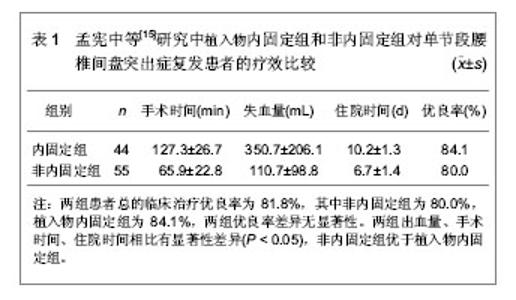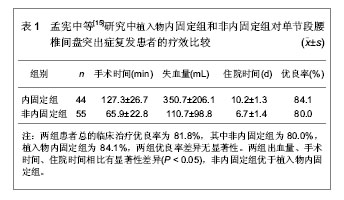| [1] 张桦,李家顺,叶晓健,等.不同术式治疗腰椎间盘突出症单纯髓核摘除术后复发的长期疗效比较[J].中国矫形外科杂志,2009, 17(3): 183-186. [2] 车艳军,陈亮,杨惠林,等.复发性腰椎间盘突出症再手术的术式选择及疗效分析[J].中国脊柱脊髓杂志,2010,20(9):730-735. [3] Erbayraktar S,Acar F,Tekinsoy B,et al.Outcome analysis of reoperations after lumbar discectomies: a report of 22 patients.Kobe J Med Sci.2002;48(1-2):33-41. [4] Yorimitsu E,Chiba K,Toyama Y,et al.Long-term outcomes of standard discectomy for lumbar disc herniation: a follow-up study of more than 10 years.Spine (Phila Pa 1976).2001; 26(6):652-657. [5] 田宝鹏,林欣.腰椎间盘突出症手术疗效探讨[J].中国康复理论与实践,2005,11(12):1039-1040. [6] 黄科峰,赵国宏,李发军,等.髓核游离型腰椎间盘脱出症CT、MRI及脊髓造影对照分析[J].放射学实践,2005,20(5):421-422. [7] Herron L.Recurrent lumbar disc herniation: results of repeat laminectomy and discectomy.J Spinal Disord.1994; 7(2): 161-166. [8] 邓宁,岑文广.腰椎间盘突出症术后复发的临床分析[J].实用骨科杂志,2011,17(10):924-926. [9] Cinotti G,Roysam GS,Eisenstein SM,et al.Ipsilateral recurrent lumbar disc herniation. A prospective, controlled study.J Bone Joint Surg Br.1998;80(5):825-832. [10] Vostreis M,Ozuna R.The role of instrumentation in the degenerative lumbar spine.Curr orthop.1999;10(5):148-153. [11] 中国知网.中国学术期刊总库[DB/OL].2013-5-15. https://www.cnki.net [12] SCI数据库.Web of Sciencevia ISI Web of Knowledge[DB/OL]. 2013-5-15.http://ip-science.thomsonreuters.com/mjl [13] Fritsch EW,Heisel J,Rupp S.The failed back surgery syndrome: reasons, intraoperative findings, and long-term results: a report of 182 operative treatments.Spine (Phila Pa 1976).1996;21(5):626-633. [14] Vishteh AG,Dickman CA.Anterior lumbar microdiscectomy and interbody fusion for the treatment of recurrent disc herniation.Neurosurgery.2001;48(2):334-337. [15] 孟宪中,孟宪国,申勇,等.不同术式治疗复发性单节段腰椎间盘突出症的疗效分析[J].中国脊柱脊髓杂志,2006,16(9):671-673. [16] 郭钧,陈仲强,齐强,等.腰椎间盘突出症术后复发的临床分析[J].中国脊柱脊髓杂志,2004,14(6):334-337. [17] 杨朝华,李克栋.腰椎间盘突出症术后复发的原因分析及预防[J].中国医药指南,2012,10(18):408-409. [18] Spengler DM,Ouellette EA,Battié M,et al.Elective discectomy for herniation of a lumbar disc. Additional experience with an objective method.J Bone Joint Surg Am.1990;72(2):230-237. [19] Osterman H,Sund R,Seitsalo S,et al.Risk of multiple reoperations after lumbar discectomy: a population-based study.Spine (Phila Pa 1976).2003;28(6):621-627. [20] Keskimäki I,Seitsalo S,Osterman H,et al.Reoperations after lumbar disc surgery: a population-based study of regional and interspecialty variations.Spine (Phila Pa 1976).2000;25(12): 1500-1508. [21] Niu CC,Chen LH,Lai PL,et al.Single cylindrical threaded cage used in recurrent lumbar disc herniation.J Spinal Disord Tech. 2005;18(suppl):65-72. [22] 刘宁.腰椎间盘突出复发相关因素分析及预防策略[J].现代诊断与治疗,2012,23(10):1753. [23] 胡文清,吕杭州,张仲,等.早期综合康复治疗预防腰椎间盘突出症术后症状复发的临床研究[J].中华物理医学与康复杂志,2010, 32(11):860-862. [24] Unglaub F,Guehring T,Lorenz H,et al.Effects of unisegmental disc compression on adjacent segments: an in vivo animal model.Eur Spine J.2005;14(10):949-955. [25] Cinotti G,Gumina S,Giannicola G,et al.Contralateral recurrent lumbar disc herniation. Results of discectomy compared with those in primary herniation.Spine (Phila Pa 1976).1999; 24(8): 800-806. [26] 陆裕朴,石凯军,黄耀添,等.腰椎间盘突出症的手术治疗[J].中华骨科杂志,1981,1(2):77-81. [27] 张德春,尹庆水,吴峰,等.腰椎间盘突出症术后复发的原因及防治[J].现代医学,2010,38(5):544-547. [28] 申勇,杨大龙,张英泽,等.复发性腰椎间盘突出症的再手术治疗[J].中国脊柱脊髓杂志,2006,16(4):255-258. [29] Fountas KN,Kapsalaki EZ,Feltes CH,et al.Correlation of the amount of disc removed in a lumbar microdiscectomy with long-term outcome.Spine (Phila Pa 1976).2004;29(22): 2521-2524. [30] Suk KS,Lee HM,Moon SH,et al.Recurrent lumbar disc herniation: results of operative management.Spine (Phila Pa 1976).2001;26(6):672-676. [31] 陈立民,姚猛,孙崇毅,等.复发性腰椎间盘突出症原因分析及预防[J].中国矫形外科杂志,2004,12(15):1182-1183. [32] Iida Y,Kataoka O,Sho T,et al.Postoperative lumbar spinal instability occurring or progressing secondary to laminectomy.Spine (Phila Pa 1976).1990;15(11):1186-1189. Borg A,Nurboja B,Timothy J,et al.Interspinous distractor devices for the management of lumbar spinal stenosis: a miracle cure for a common problem?Br J Neurosurg.2012; 26(4):445-449. |

